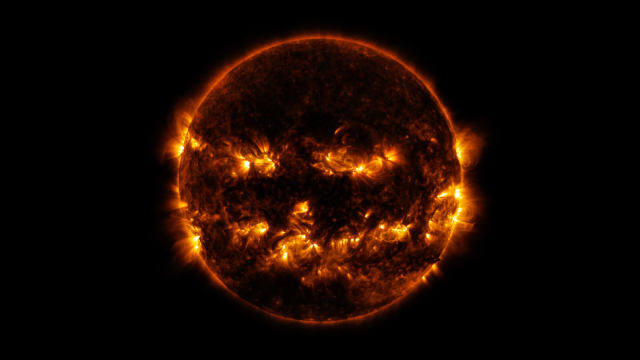In space, it has been said, no one can hear you scream. That may very well be the case, but that doesn’t mean space isn’t filled with an abundance of strange sounds in the form of radio bursts, electromagnetic pulses, solar wind, charged particle bursts and other celestial emissions. We can’t hear these sounds in their raw form, so NASA has converted them into an audible format suitable for our ears – and the results are unsettling.
NASA image from 8 October 2014 show active regions on the Sun that give it a very jack-o’-lantern-like appearance. (Image: NASA/GSFC/SDO)
There are over 20 different space sounds featured in NASA’s new playlist, including Jovian magnetic burps, plasma waves and interstellar light curves. These weird blips, screeches and swoops are sure to make your hair stand on end.
NASA has provided explanations for some of these sounds:
Juno Captures the ‘Roar’ of Jupiter: NASA’s Juno spacecraft has crossed the boundary of Jupiter’s immense magnetic field. Juno’s Waves instrument recorded the encounter with the bow shock over the course of about two hours on June 24, 2016.
Plasma Waves: Plasma waves, like the roaring ocean surf, create a rhythmic cacophony that — with the EMFISIS instrument aboard NASA’s Van Allen Probes — we can hear across space.
Saturn’s Radio Emissions: Saturn is a source of intense radio emissions, which were monitored by the Cassini spacecraft. The radio waves are closely related to the auroras near the poles of the planet. These auroras are similar to Earth’s northern and southern lights. More of Saturn’s eerie-sounding radio emissions.
Sounds of Jupiter: Scientists sometimes translate radio signals into sound to better understand the signals. This approach is called “data sonification”. On June 27, 1996, the Galileo spacecraft made the first flyby of Jupiter’s largest moon, Ganymede, and this audio track represents data from Galileo’s Plasma Wave Experiment instrument.
Sounds of a Comet Encounter: During its Feb. 14, 2011, flyby of comet Tempel 1, an instrument on the protective shield on NASA’s Stardust spacecraft was pelted by dust particles and small rocks, as can be heard in this audio track.
Be sure to have this playlist handy when trick-or-treaters pay you a visit this Halloween.
[NASA]
